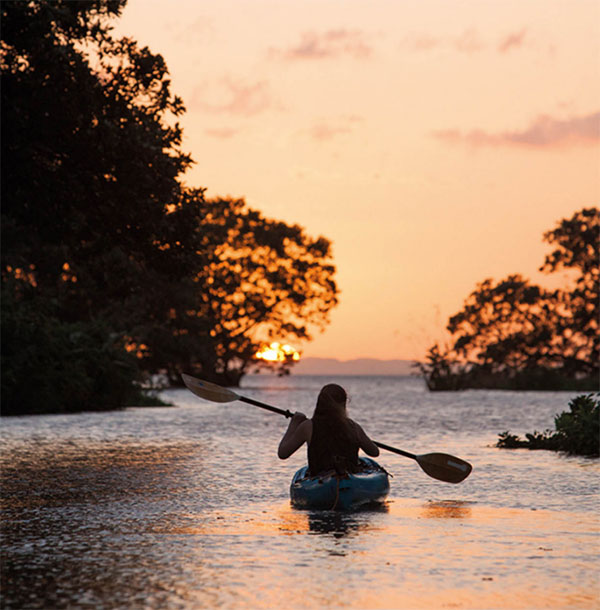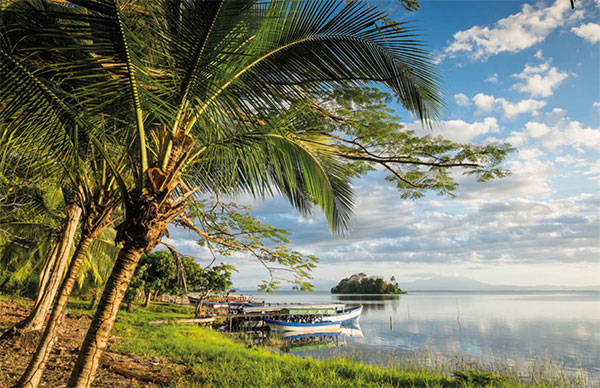SHARKS
The relatively shallow waters of Lake Nicaragua are the last place anyone would expect to find a shark. Their appearance surprised scientists who believed they were a unique freshwater species – until 1976, when the University of Nebraska-Lincoln’s Thomas B. Thorson tagged some of them, revealing that highly adaptable Caribbean bull sharks (Charcharinus leucus) were able to swim the 193km (120 miles) span of the San Juan River from the Atlantic coast. The sharks have adapted to the freshwater and can grow up to 3 meters (11ft) in length. A Japanese shark-fin factory was established near Granada during the Somoza regime, and even though it closed in 1970, the population of bull sharks has yet to recover. Plus, with increasing habitat destruction, its likely that the sharks could disappear.
Agencies in town can arrange tours east along the San Juan River, where there are several unique hotels. A Spanish-built fortress can be seen at El Castillo (daily), which is much stronger than the one in San Carlos. It dates from 1673 and was commissioned after Granada was repeatedly sacked by pirates. A 20-minute drive farther east takes you to the 2,606-sq-km (1,006 sq mile) Reserva Biológica Indio-Maíz, the second largest tract of rainforest in Nicaragua. While most of the reserve is off limits to all but scientists, some portions are accessible to tourists, including from the all-inclusive Rio Indio Ecolodge (www.therioindiolodge.com), which has a resort atmosphere.
Los Guatuzos Wildlife Reserve
On the south side of the lake on the Costa Rican border, where it connects with the Caño Negro Wildlife Refuge on the other side, the Los Guatuzos Wildlife Reserve is one of the most pristine ecosystems in Nicaragua, with more than 400 species of birds and a healthy population of jaguars. Descendants of the Zapote and Guatuzo people live within a few small fishing communities hidden in the mangroves and can provide rustic rooms and meals, usually set up through the CANTUR office in San Carlos, which can arrange boat transportation into the preserve.

Kayaking on Lake Nicaragua at sunset.
Getty Images
Archipiélago de Solentiname
In the quietest corner of Lake Nicaragua, the 30-plus small tropical islands that make up the Archipiélago de Solentiname ^ [map] have been the unlikely center of the internationally renowned primitive art movement. In the 1960s, the poet and priest Ernesto Cardenal helped inspire the islanders to paint the flora and fauna around them. Other artists came, as did television crews to capture the phenomenon, and today many of the roughly 1,000 residents here make a living painting and carving sculptures of local fauna out of balsawood. Most tourist amenities, which are few, are concentrated in Mancarrón, the largest island and where Cardenal based his colorful parish in the whitewashed Iglesia Nuestra Señora de Solentiname. There’s a small archeological museum and a couple of small guesthouses here as well.

The Solentiname islands are located towards the southern end of Lake Nicaragua.
Getty Images
The Pacific coast
Much of the attention Nicaragua has received in recent years has been focussed on the south of the country, particularly the narrow stretch of land between the Pacific coast and Lake Nicaragua. Many travelers coming up from Costa Rica looking for the next great beach destination found it long ago in San Juan del Sur and the collection of surfing and fishing villages, isolated coves, and bays up and down the coast. With improving highways and the Costa Esmeralda airport – offering regular flights to Managua – much more development is expected in the coming years. Closer to the lake, the old colonial town of Rivas, long faded into memory, is taking on a new lease of life as the transportation hub of the region.
Rivas and around
Located on the Pan-American highway along the shore of Lake Nicaragua is Rivas & [map] , 110km (68 miles) south of Managua. While many passing through Rivas only see a highway lined with modern buildings and gas stations, its charming Parque Central and 18th-century church is surrounded by a Spanish-designed grid of streets that are still full of original architecture. It’s where tyrant William Walker failed to penetrate and also the birthplace of former president, Violeta Chamorro, who is credited with reuniting the war-torn country in the 1990s.
East of Rivas, opposite the highway is San Jorge, with a long windswept beach and a bustling port offering with regular ferry services to Ometepe. There are a few traditional restaurants and B&Bs within walking distance of the port.